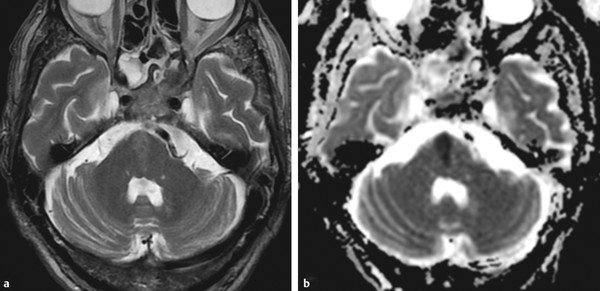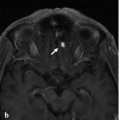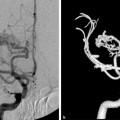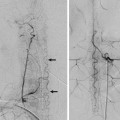The Brainstem Perforators
21.1 Case Description
21.1.1 Clinical Presentation
An 80-year-old man presented with progressive symptoms of dizziness, ataxia, multiple episodes of loss of consciousness, double vision, and skew deviation. His symptoms progressed despite best medical treatment.
21.1.2 Radiologic Studies
See ▶ Fig. 21.1, ▶ Fig. 21.2.

Fig. 21.1 Left vertebral artery (VA) angiograms in anteroposterior (a,c) and lateral (b–d) views before (a,b) and after (c,d) angioplasty and stenting. There is a tight midbasilar artery stenosis resulting from a posteriorly located plaque, with a slow flow toward the basilar tip (a,b). This was thought to be responsible for the patient’s symptoms, and treatment with stent-assisted angioplasty was performed, with good reopening of the basilar artery and brisk filling of the basilar circulation (c,d). Note the improved flow to the posterior circulation after the procedure. The patient woke up from anesthesia with a left facial droop, slurred speech, and mild weakness in the left arm and left leg.

Fig. 21.2 Axial T2-weighted MRI (a) and apparent diffusion coefficient map (b) after angioplasty and stenting reveal a right medial brainstem perforator infarct.
21.1.3 Diagnosis
Basilar artery perforator stroke after percutaneous transluminal angioplasty and stenting of a mid-basilar artery stenosis.
21.2 Embryology and Anatomy
The basilar artery gives rise to three different groups of arteries: the cerebellar arteries (anterior inferior cerebellar artery [AICA] and superior cerebellar artery, and in approximately one-quarter of patients, the posterior inferior cerebellar artery as well), the pontine arteries (pontomedullary, superior and inferior long lateral pontine, and posterolateral arteries) and the basilar perforators.
While the pontine arteries are circumferential arteries to supply the lateral (short circumferential) and the dorsolateral (long circumferential branches) parts of the pons in its caudal (pontomedullary arteries), middle (long lateral pontine arteries), and superior (posterolateral artery) portion, the central parts of the pons are supplied by the basilar artery perforators. Three groups of perforators can be distinguished: the caudal, the middle, and the rostral groups. Within each of these groups, 1 to 10 individual perforators can be identified that may originate from a common trunk or, less commonly, individually from the basilar artery.
Stay updated, free articles. Join our Telegram channel

Full access? Get Clinical Tree








